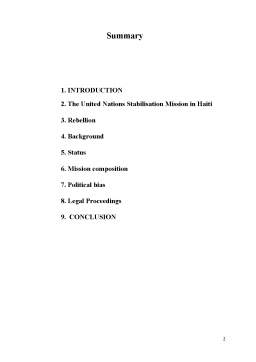Cuprins
- 1. INTRODUCTION
- 2. The United Nations Stabilisation Mission in Haiti
- 3. Rebellion
- 4. Background
- 5. Status
- 6. Mission composition
- 7. Political bias
- 8. Legal Proceedings
- 9. CONCLUSION
Extras din referat
INTRODUCTION
The current context of global conflicts determine army troops to fight in complex and prolonged conflicts.The army opperates for extended periods across every spectrum of conflict: from stabile peace, to general war , and to stabile peace again.
Success in Stability and Support Opeerations requires efforts from diplomatic informational military and ecnomic power.Therefore , the military has to cooperate with non-governmental Organisations ; private Organisations and even with single individuals. 21th century means more than combat between armed opponents , but simultaneously shape the border situation from non-little actions to restore security and normalcy to the local population.
Stability and support operations is a US military term for operations involve military forces providing safety and support to friendly noncombatants while suppressing threatening forces.
SASO operations can occur in everything from natural disaster areas (earthquakes, storms and flooding) to insurgencies (revolts, social upheavals). The extent of SASO operations can range from interacting with the local population to military operations with specific rules of engagement.
The United Nations Stabilisation Mission in Haiti
The United Nations Stabilisation Mission Haiti (UNSTAMIH), also known as MINUSTAH, an acronym of the French translation, is a United Nations peacekeeping mission in Haiti that has been in operation since 2004. The mission's military component is led by the Brazilian Army and the force commander is Brazilian. MINUSTAH's mandate was most recently extended by United Nations Security Council Resolution 1944 past its October 15, 2010 deadline amid fears of instability. The mission's current mandate runs through October 15th, 2011 with the intention of further renewal. The force is composed of 8,940 military personnel and 3,711 police, supported by an international civilian personnel, a local civilian staff and United Nations Volunteers.
Following the 2010 Haiti earthquake, the United Nations reported that the headquarters of the mission in Port-au-Prince had collapsed and that the mission's chief, Hédi Annabi of Tunisia, his deputy Luiz Carlos da Costa of Brazil, and the acting police commissioner, the Royal Canadian Mounted Police's Doug Coates of Canada, were confirmed dead. On 14 January 2010, UN headquarters dispatched the former head of MINUSTAH and current Assistant Secretary-General for Peacekeeping Operations, Edmond Mulet, as the organisation's Acting Special Representative of the Secretary-General and interim head of MINUSTAH. Mulet clarified on January 22 that MINUSTAH will concentrate on assisting the Haitian National Police in providing security within the country after the earthquake, while American and Canadian military forces will distribute humanitarian aid and provide security for aid distribution.
Rebellion
In September 2003, Amiot Metayer was found dead, his eyes shot out and his heart cut out, most likely the result of machete-inflicted wounds. He was, prior to his death, the leader of the Gonaives gang known as "The Cannibal Army." After his death, his brother Buteur Metayer swore vengeance against those he felt responsible for Amiot's death—namely, President Jean-Bertrand Aristide. Buteur took charge of the Cannibal Army and promptly renamed it the National Revolutionary Front for the Liberation of Haiti.
On February 5, 2004, this rebel group seized control of Haiti's fourth-largest city, Gonaïves, marking the beginning of a minor revolt against Aristide. During their sack of the city, they burned the police station and looted it for weapons and vehicles, which they used to continue their campaign down the coast. By February 22, the rebels had captured Haiti's second-largest city, Cap-Haïtien. As the end of February approached, rebels controlled the capital, Port-au-Prince, fueling increasing political unrest. Haitians fled their country on boats, seeking to get to the United States. Haiti was called an "economic basket-case", beset by a brain drain of its intellectual talent, a population boom and widespread corruption.
On February 25, 2004, the U.S. lawyer representing the government of Haiti claimed that the rebellion was supported by the United States and led by a former death squad member; he said, "This is clearly a military operation, and it’s a military coup." After a three-week rebellion, Aristide voluntarily or involuntarily left Haiti on a US plane accompanied by US security personnel as the rebels took over the capital and was flown, with or without knowledge of his route and destination, via Antigua to Bangui, Central African Republic.
Preview document
Conținut arhivă zip
- Stability and Support Operations in Haiti.doc
- Stability and Support Operations in Haiti.ppt











